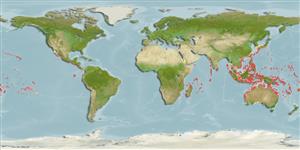Actinoptérygiens (poissons à nageoires rayonnées) >
Syngnathiformes (Pipefishes and seahorses) >
Syngnathidae (Pipefishes and seahorses) > Syngnathinae
Etymology: Halicampus: Greek, als, alis = salt + Greek, kampe = bend (Ref. 45335).
Environnement / Climat / Gamme
Écologie
; marin récifal; profondeur 4 - 26 m (Ref. 86942). Tropical, preferred ?
Indo-Pacific: Sri Lanka, Taiwan, Thailand, Vietnam, Western Australia and Queensland (Australia), and Tutuila Island, American Samoa, Marshall Islands,
Length at first maturity / Taille / Poids / Âge
Maturity: Lm ?, range 10 - ? cm
Max length : 12.0 cm TL mâle / non sexé; (Ref. 48635)
Description synthétique
Morphologie | Morphométrie
Rayons mous dorsaux (Total): 19-20; Rayons mous anaux: 3. Brown with about 4 broad black bands on trunk, each separated by a thin white bar (Ref. 48635).
Adults inhabit rock or coral habitats. Ovoviviparous (Ref. 205). The male carries the eggs in a brood pouch which is found under the tail (Ref. 205). Males may be brooding at about 10 cm SL. Also seen in sheltered water, often on rubble bottoms in 2-12 m (Ref 90102).
Life cycle and mating behavior
Maturité | Reproduction | Frai | Œufs | Fécondité | Larves
Male carries the eggs in a brood pouch (Ref. 205).
Dawson, C.E., 1985. Indo-Pacific pipefishes (Red Sea to the Americas). The Gulf Coast Research Laboratory Ocean Springs, Mississippi, USA. (Ref. 5316)
Statut dans la liste rouge de l'IUCN (Ref. 115185)
CITES (Ref. 94142)
Not Evaluated
Menace pour l'homme
Harmless
Utilisations par l'homme
Plus d'informations
Taille/ÂgeCroissanceLongueur-poidsLongueur-longueurFréquences de longueursMorphométrieMorphologieLarvesDynamique des populations larvairesRecrutementAbondance
RéférencesAquacultureProfil d'aquacultureSouchesGénétiqueFréquences alléliquesHéritabilitéPathologiesTraitementMass conversion
CollaborateursImagesStamps, CoinsSonsCiguateraVitesseType de nageSurface branchialeOtolithesCerveauxVision
Outils
Articles particuliers
Télécharger en XML
Sources Internet
